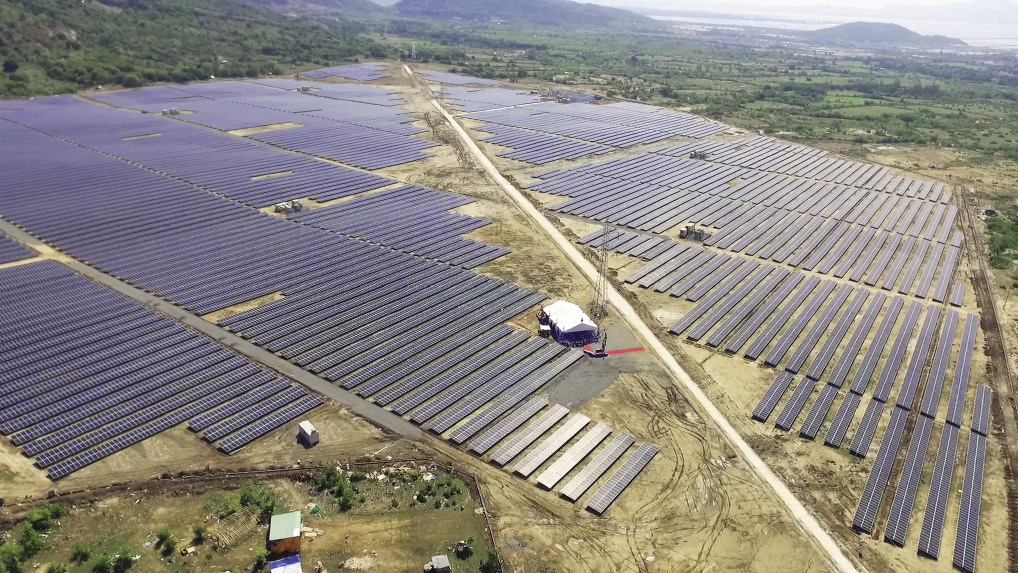From pv magazine Australia.
As developers scrambled to meet the end of June deadline to tap a generous feed-in tariff scheme, Vietnam saw unprecedented activity in its utility scale solar market, with multi gigawatts of PV capacity connected to the grid.
While Australia and Vietnam have been progressively expanding over 12 months, the latest tally showed the Southeast Asian country had overtaken Australia for operating utility scale solar PV capacity, according to Norwegian consultancy Rystad Energy.
Building on the previous year’s record volume of new large scale PV capacity, Australia continued to expand its portfolio of commissioned projects. According to Rystad’s data, the nation’s operating capacity rose from less than 600 MW to 2.7 GW over 12 months. However, that performance was put in the shade as the Vietnamese market skyrocketed on the back of June installation figures, from less than 10 MW of operational generation capacity in June 2018 to more than 4 GW – a 400-fold increase.
More than 60% of that capacity was commissioned last month, Rystad found. The average time for construction and commissioning in Vietnam was an astonishing 275 days.
“Few would have predicted Vietnamese utility PV to exceed Australia’s by mid-year,” said David Dixon, senior analyst on Rystad Energy’s renewables team. “The commissioned capacity in Vietnam has exceeded our high case.”

The Vietnamese boom
Rystad’s prediction was that 40 solar projects with a total generation capacity of 2 GW were due to come online in Vietnam this year, itself a big leap from just two large scale projects – the 49 MW Krong Pa and 35 MW Duc Hue PV farms – commissioned last year. However, according to Vietnamese state-owned utility EVN’s latest data, as many as 82 plants with a combined capacity of 4.46 GW were connected to the national grid by the end of June.
Popular content
Previously, the Vietnamese government had said it was expecting 4 GW of solar capacity to be rushed towards commercial operation by Sunday’s deadline.
By mid-April Vietnam had connected only four solar plants with a cumulative capacity of 150 MW to the grid. By the end of May, however, 34 more facilities with a cumulative capacity of 2.2 GW had been added. The government said it expected another 54 solar projects to come online last month, and therefore qualify for a 20-year FIT of US$0.0935/kWh set in April 2017.
“The main concern in Vietnam is the risk of grid overload once these plants are completed,” Rystad analyst Minh Khoi Le had said as the solar scramble was under way. “EVN, the country’s only utility company will need to find more free space in the grid or these plants will not be producing to their designed capacity.”
Rystad was not alone in underestimating the Vietnamese boom. In a report published in November, the Asian Development Bank predicted solar to increase from a capacity of 368 MW at the end of 2017 to 850 MW – 0.5% of overall electricity generation – next year, 4 GW in 2025 (1.6%) and 12 GW (3.3%) in 2030.
Market research company IHS Markit had tipped Vietnam to be one of the most promising PV markets this year and forecast the emerging markets of Argentina, Egypt, South Africa, Spain and Vietnam together would account for 7% of the 2019 market – for 7 GW of new capacity. Having added just 8 MW of new solar capacity in 2017, Vietnam plugged in 106 MW last year and the nation is poised to take things to another level with IHS Markit analyst Josefin Berg projecting 2 GW will be installed in the utility scale sector alone this year.
Looking ahead
Following the period of breakneck development, the Vietnamese market is surely now in for a slowdown. According to EVN, another 13 solar plants are scheduled to be connected to the grid this year, for 630 MW of combined new capacity.
“We forecast an additional 0.8 GWac being commissioned in the second half of 2019 in Australia, approaching a total of 3.5 GWac by year-end,” added Rystad’s Dixon. “Yet this is still less than Vietnam’s commissioned capacity at the time of writing.”
This content is protected by copyright and may not be reused. If you want to cooperate with us and would like to reuse some of our content, please contact: editors@pv-magazine.com.



8 comments
By submitting this form you agree to pv magazine using your data for the purposes of publishing your comment.
Your personal data will only be disclosed or otherwise transmitted to third parties for the purposes of spam filtering or if this is necessary for technical maintenance of the website. Any other transfer to third parties will not take place unless this is justified on the basis of applicable data protection regulations or if pv magazine is legally obliged to do so.
You may revoke this consent at any time with effect for the future, in which case your personal data will be deleted immediately. Otherwise, your data will be deleted if pv magazine has processed your request or the purpose of data storage is fulfilled.
Further information on data privacy can be found in our Data Protection Policy.